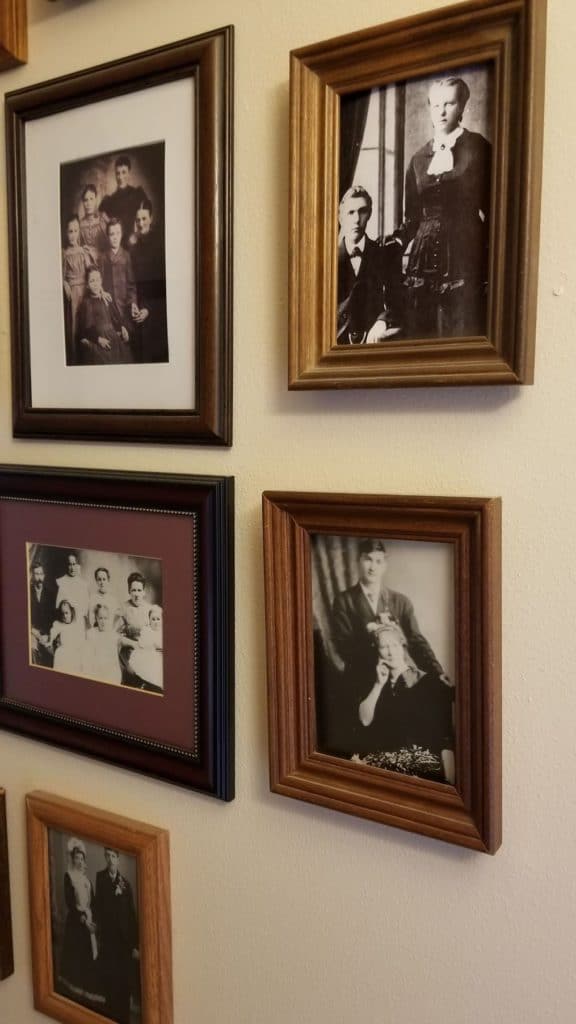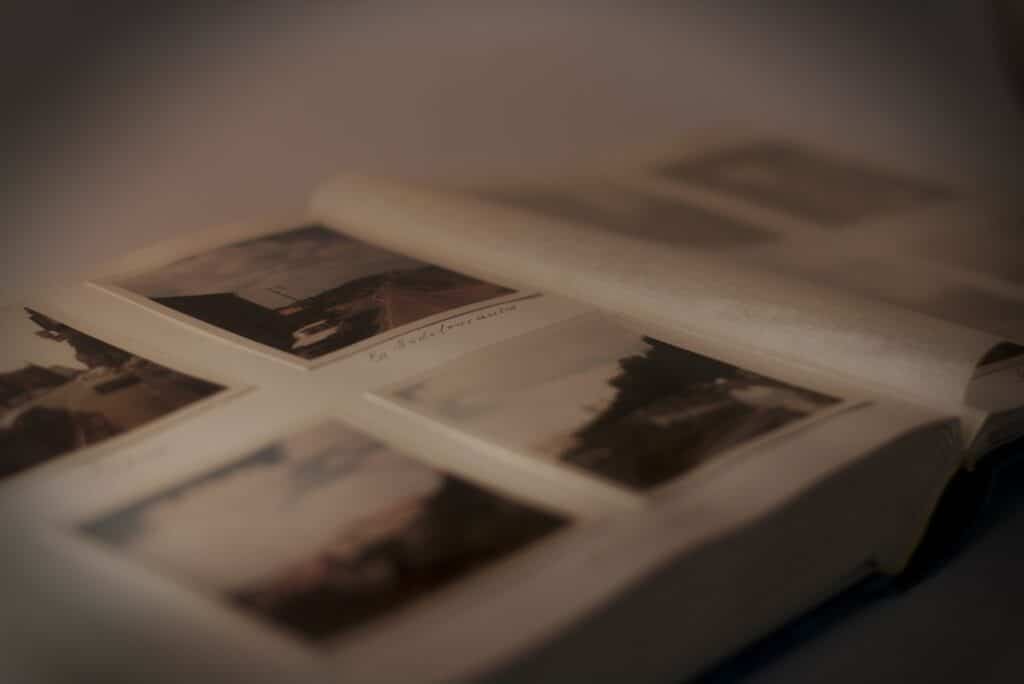For the family history researcher, finding a stash of old family photos can be a true genealogy jackpot! And while our first inclination might be to hang them right up on the wall for everyone to see – this may not be the best idea. Photographs are fragile things, and old ones are especially vulnerable to the effects of the environment in which they are kept. Here are some steps you should take to preserve old photos so that they can be enjoyed for years to come.
How to Preserve Old Family Photos
- Carefully scan your old photos and negatives
- Upload the scans to cloud storage
- Print and frame copies you’d like to display
- Store the originals in a controlled environment
1. Scan your old photos and negatives and store them online
Old photographs are extremally delicate and are likely to fade, chip or tear over time. So, even if you store them properly, the best way to preserve old photos for the future is to digitally scan and store them safely online.
Old photos can be scanned individually or in their albums. It is especially important not to remove photos from albums if they have been there for a long period of time, or have been glued in place, as this may damage them.
Take a look at this article about the best apps for scanning old photos, and you can find help for scanning old negatives here. The process is surprisingly easy and many available apps also have storage available to simplify the process further. Or you can upload the digital copies to an existing cloud account – anywhere you know you will maintain access to for a long period of time.
2. Store old photos in a controlled environment
Of course, you’ll also want to preserve the originals. Old photographs need to be protected in certain ways to keep them away from environmental hazards that can damage them.
The National Archives has provided recommendations regarding how old photographs and documents should be stored. You don’t need to check off all of these suggestions, something is better than nothing, but the more you can do to protect these family treasures the better.
The best way to store old photos:
- Store them in appropriate containers where they can lay flat. Photos can be placed in archival quality albums, enevelopes or sleeves to protect further them.
- Never remove old photos from albums if they have been there for a long time or are glued in place. This may damage them.
- Store them at constant temperatures below 75 degrees Fahrenheit. Cooler temperatures mean better long-term preservation.
- Keep the humidity levels in photo storage areas between 15% and 65% to avoid decay.
- Avoid storing old photographs in attics, basements, or garages where temperature and humidity tend to fluctuate. This can lead to mold, chemical decay, or brittleness.
- Keep your photos away from areas that are prone to insects and rodents. These “critters” like to use paper to nest and may chew holes in your prized photos.
- Store old photographs up on shelves and away from areas that are prone to leaks to avoid water damage.
The correct materials for preserving and storing your old photos
Once you have copied your old photographs and selected an area to store your originals, don’t just shove them in a cardboard box or that photo album you bought at the dollar store. Certain chemicals and plastics can cause your old photographs to decay or stick together.
Here are some rules you should follow when storing your photographs in albums or boxes:
- Use archival quality paper or cardboard to store your photos. This means the pages in your photo album should be acid-free and lignin free. The material that your photo box is made of should be the same. You can also use stable plastic photo pockets or sleeves, such as products made of polyester, polyethylene, or polypropylene.
- If storing your old photos in a box, make sure the box is big enough that your photos can be stored flat or upright with no creasing or bending. If storing your photos upright, use spacer boards to keep your photos from bending.
- When placing your old family photos in a photo album, do not use tape or glue to keep them in place as this can lead to staining and paper damage. Also, avoid magnetic photo pages. Mount your photos on acid-free paper album pages using acid-free or stable plastic mounting corners or place your photos in stable plastic photo album pages.
3. Display them properly to avoid fading
Because photos are are sensitive to light and may fade or discolor if exposed for long periods, it’s also important to make copies of them if you plan to display old family photos in your home. The older the photograph, the more vulnerable the image becomes. Once you have scanned your images you can easily order prints from a number of sites, or take them to a local photo printer, to create ones you can frame and display.
The pictures below are copies, displayed in the hallway of my home.
If you are unsure of how to copy your old photographs, or if the photos you want to copy are very fragile, you may want to seek out a photo restoration professional to do this for you. It is especially a good idea to take your old photos to a professional for restoration if they have been in antique frames for years.
If you simply must display an original photograph, or your old photograph is carefully preserved in an antique frame and you don’t want to mess with it, be picky about where you hang that old photo.
Select a spot in your home that is not directly exposed to sunlight, fluorescent light, or UV light. Make sure the location is not at risk for leaks or exposure to insects and rodents. Also make sure the location is temperature and humidity controlled. A dark corner of a main floor den or hallway often provides a good place to display an old photograph.
This portrait of my grandmother and her younger brother (below) was taken about 1908. It is mounted in one of those old oval antique frames and I don’t want to touch it! I have it displayed in a darker corner of my den, away from the window. 
If you follow these recommendations, you should be able to preserve your old family photographs for many years. Here’s hoping you find that photo “jackpot” to help your genealogy research!
You may also like:
The 3 Free Scanning Apps That Helped Reveal Long Hidden Details in This Old Photo
Why Weren’t Your Ancestors Smiling in Those Old Photos? The Reason Revealed
The 4 Best Free or Low-Cost Cloud Storage Solutions for Backing Up Your Genealogy Files
By Janet Meydam. Janet is a freelance writer who has over 40 years of experience in genealogy research. Her knowledge includes researching many different records from the United States, Germany and Poland. She is also a co-author of her parents’ family history book “I Come from a Long Line of Dilleys.”

In response to Fabel Konicke (11/14/2023) ~ (I’ve had to do this with photographs before.) If it’s a “real” photograph (printed on photographic paper), you can try submersing the photo and glass in water – It won’t hurt the photo (when photos are developed, they’re ‘washed’ in a water bath), and it may loosen the stuck part from the glass. (After it’s been submersed for some time, if it doesn’t just come loose on it’s own, you can (Gently/Carefully/Slowly) try separating the photograph from the glass.)
Hope this helps!
Meg Dondero,
Mi-Wuk Village, CA
([email protected])
I discovered a family approx. 3×4 inch photo album. Photos are easy to remove to house in sleeves. I worry about the tin types darkening and the card photos fading due to the acetate in the album. Is it a sin to remove to preserve the photos? What is the pitfall to remove them?
I discovered a family approx. 3×4 inch photo album. Photos are easy to remove to house in sleeves. I worry about the tinctures darkening and the card photos fading due to the acetate in the album. Is it a sin to remove to preserve the photos? What is the pitfall to remove them?
Thank you so much. Great info. I have a photo of my husbands great aunt on her 100th birthday that I love. Somehow probably during move – it got exposed to some water. It is stuck to glass. Any idea how i could dislodge it without damaging it further? Thank you